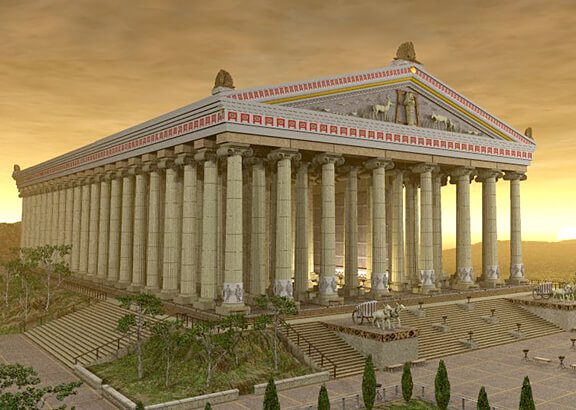
The Artemision , considered one of the seven wonders of the World was indeed a building unparalleled in splendour. This is because it was the largest edifice in the Hellenic World and also the first architectural work of monumental proportions ever to be conducted entirely of marble.
Before the coming of the Greeks, the site of the temple of Artemis was occupied by an area sacred to the Anatolian mother goddess Kybele who was worshipped by the local inhabitans. Excavations undertaken by archeologists have proved the existence of three building phases before the archaic Artemision of an altar and a naiscos.
So we can date Artemis temple in two different timing. One as Archaic Artemision and Later Artemision. The golden age of the Ionian World reached its peak in the second quarter of the sith century B.C. Consequently, a temple of the modest proportions stated above would not have sufficed for a wealthy city-state the size of Ephesus. Moreover, in 570 B.C. or slightly earlier, work was begun on a temple on Samos with a stylobate measuring 52x105 m. Two architects called Rhoikos and Theodoros were in charge of the construction, which was intended to replace the outdated small Heraion. The Ephesians would not allow a rival city to get ahead of them and they lost no time in sending to Crete for Cherisphron of Knossos and his son Metagenes to come and construct a huge and magnificent temple. In addition, they got the architect Theodoros to come from Samos, since they were compelled to set the foundations of the ephesian Artemision in swampy ground, just as those of the Heraion on Samos had been. However , it is apparent that the services of the guest architect were not required only fort he laying of the foundations, since in many respects, the Artemision resembles the Heraion. Neverthless, a work of art was created which was in every way more beautiful and more mature. It may well be that the Cretan architects had an intimate knowledge of Egyptian, Assyrian and Hittite architecture and sculpture, which inspired them. It is also possibile that they had produced other large scaled buildings before this. Temple in great part was completed untill 550 B.C. but some restorations were made in the fifth century.
The magnificence and beauty of the archaic Artemision was a source of admiration for a period of one hundred years. However, in 356, the year of Alexander the Great’s birth, a man called Herostratos, idiotically in search of fame, had the idea of rendering his name immortal by setting the temple on fire. The ceiling and inner architrave, being made of wood, were completely destroyed in the blaze. Before marching against Persia in 334, Alexander offered up sacrifices amid the ruins of the Artemision and expressed the desire to undertake its reconstruction. According to Strabo, the Ephesians acknowledged his proposal with this superb but flattering refusal : ‘’It is not fitting for a God to build a temple for another God’’ . Thereupon, the city of Ephesus decided to rebuild Artemision according to its original plan.
Consequently, new columns and walls rose up on the same sites of the originals.
